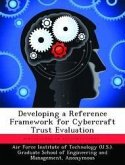The Air Force Research Laboratory (AFRL) Information Directorate (RI) is researching a next generation network defense architecture, called Cybercraft, that will provide automated and trusted cyber defense capabilities for AF network assets. In this research, we consider the issues of how to protect or obfuscate command and control aspects of the system. In particular, we present a methodology to hide aspects of Cybercraft platform initialization in context to formation of hierarchical, peer-to-peer groups that collectively form the Cybercraft network. This research will subject Bothunter to a series of tests to validate these claims. We use a leading bot detection utility, Bothunter, and an ARP validation tool, XArp, to build a case for the e ectiveness of our approach. We present three scenarios that correlate to how we believe Cybercraft platforms will be integrated in the future and consider stealthiness in terms of these representative tools.
Hinweis: Dieser Artikel kann nur an eine deutsche Lieferadresse ausgeliefert werden.
Hinweis: Dieser Artikel kann nur an eine deutsche Lieferadresse ausgeliefert werden.








![Narrative of the Failure of an Attempt to Establish a Great National Institution [microform]: Intended, More Especially, for the Reception of Orphan C Narrative of the Failure of an Attempt to Establish a Great National Institution [microform]: Intended, More Especially, for the Reception of Orphan C](https://bilder.buecher.de/produkte/65/65495/65495765m.jpg)